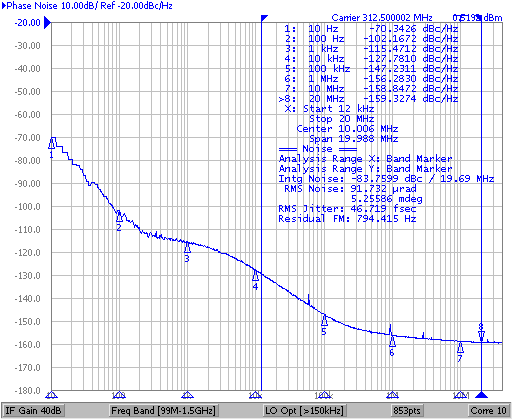JAJSKW2B June 2020 – June 2021 LMK05318B
PRODUCTION DATA
- 1 特長
- 2 アプリケーション
- 3 概要
- 4 Revision History
- 5 概要 (続き)
- 6 Pin Configuration and Functions
- 7 Specifications
- 8 Parameter Measurement Information
-
9 Detailed Description
- 9.1 Overview
- 9.2 Functional Block Diagram
- 9.3
Feature Description
- 9.3.1 Oscillator Input (XO_P/N)
- 9.3.2 Reference Inputs (PRIREF_P/N and SECREF_P/N)
- 9.3.3 Clock Input Interfacing and Termination
- 9.3.4 Reference Input Mux Selection
- 9.3.5 Hitless Switching
- 9.3.6 Gapped Clock Support on Reference Inputs
- 9.3.7 Input Clock and PLL Monitoring, Status, and Interrupts
- 9.3.8
PLL Relationships
- 9.3.8.1 PLL Frequency Relationships
- 9.3.8.2 Analog PLLs (APLL1, APLL2)
- 9.3.8.3 APLL Reference Paths
- 9.3.8.4 APLL Phase Frequency Detector (PFD) and Charge Pump
- 9.3.8.5 APLL Feedback Divider Paths
- 9.3.8.6 APLL Loop Filters (LF1, LF2)
- 9.3.8.7 APLL Voltage Controlled Oscillators (VCO1, VCO2)
- 9.3.8.8 APLL VCO Clock Distribution Paths (P1, P2)
- 9.3.8.9 DPLL Reference (R) Divider Paths
- 9.3.8.10 DPLL Time-to-Digital Converter (TDC)
- 9.3.8.11 DPLL Loop Filter (DLF)
- 9.3.8.12 DPLL Feedback (FB) Divider Path
- 9.3.9 Output Clock Distribution
- 9.3.10 Output Channel Muxes
- 9.3.11 Output Dividers (OD)
- 9.3.12 Clock Outputs (OUTx_P/N)
- 9.3.13 Glitchless Output Clock Start-Up
- 9.3.14 Clock Output Interfacing and Termination
- 9.3.15 Output Synchronization (SYNC)
- 9.3.16 Zero-Delay Mode (ZDM) Synchronization for 1-PPS Input and Output
- 9.4 Device Functional Modes
- 9.5 Programming
- 10Application and Implementation
- 11Power Supply Recommendations
- 12Layout
- 13Device and Documentation Support
- 14Mechanical, Packaging, and Orderable Information
パッケージ・オプション
メカニカル・データ(パッケージ|ピン)
- RGZ|48
サーマルパッド・メカニカル・データ
- RGZ|48
発注情報
5 概要 (続き)
DPLL はジッタおよびワンダ減衰用のプログラミング可能なループ帯域幅をサポートし、2 つの APLL はフラクショナル周波数変換をサポートしていることから、柔軟なクロック生成が実現します。DPLL でサポートする同期オプションには、位相キャンセレーションによるヒットレス・スイッチング、デジタル・ホールドオーバー、および 0.001ppb 未満の周波数ステップ・サイズにより高精度のクロック・ステアリング (IEEE 1588 PTP スレーブ) を実現する DCO モードがあります。DPLL は 1PPS (pulse-per-second) の基準入力にフェーズ・ロックし、1つの出力でオプションのゼロ遅延モードをサポートできるため、プログラム可能なオフセットによって、決定性の入出力位相アライメントを実現します。高度な基準入力監視ブロックが、強力なクロック異常検出を実行し、基準喪失 (LOR) 時の出力クロックの乱れを最小限に抑えることができます。
一般的な低周波数の TCXO/OCXO を使用して、同期標準に準拠したフリーランまたはホールドオーバー出力周波数安定性を確保できます。あるいは、フリーランまたはホールドオーバー時の周波数安定性やワンダが重視されない場合には、標準の XO を使用できます。このデバイスは、I2C または SPI インターフェイスによって完全にプログラミング可能であり、内蔵 EEPROM または ROM による起動時のカスタム周波数設定にも対応しています。EEPROM は出荷時に書き込み済みであり、必要に応じてインシステム・プログラミングも可能です。
